Articles
- Page Path
- HOME > J Korean Acad Nurs > Volume 38(6); 2008 > Article
-
Original Article
- Development of a Structural Equation Model to estimate University Students' Depression
- Kwang-Hi Park
-
Journal of Korean Academy of Nursing 2008;38(6):779-788.
DOI: https://doi.org/10.4040/jkan.2008.38.6.779
Published online: December 31, 2008
Part-time Instructor, College of Nursing, Seoul National University, Seoul, Korea.
- Address reprint requests to: Park, Kwang-Hi. College of Nursing, Seoul National University, 28 Yeongeon-dong, Jongno-gu, Seoul 110-744, Korea. Tel: 82-2-740-8835, Fax: 82-2-766-1852, nurse0302@hanmail.net
• Received: July 30, 2008 • Accepted: November 2, 2008
Copyright © 2008 Korean Society of Nursing Science
Abstract
-
Purpose
- This study was designed to construct a structural model explaining depression in university students.
-
Methods
- Data were collected from 1,640 university students by questionnaire, and analyzed using AMOS 5.0 to test the hypothetical model.
-
Results
- Fitness statistics for the modified model were GFI=.93, AGFI=.89, NFI=.91, and RMSEA=.081. All the 12 paths in the modified model proved to be statistically significant. Depression of university students accounted for 52% of the covariance by the factors. The factor that had the most influence on depression was individual vulnerability, and followed by sequence order, stress, social support, coping, and self-efficacy. Depression was influenced directly by individual vulnerability, stress, social support, and coping, and indirectly by individual vulnerability, stress, social support, and selfefficacy.
-
Conclusion
- A screening and management system for the high risk group is needed to effectively prevent depression and reduce rate of depression in university students. Detailed support programs which specifically deal with prevailing stressors should be developed to effectively reduce the harmful effects of individual vulnerability and stress. It is anticipated that the model constructed in this study could be utilized as a reference in developing various strategies to prevent and intervene depression in university students.
- 1. Bandura A. Self-efficacy: The exercise of control. 1997;New York, NY, W. H. Freeman and Company.
- 2. Battle J. Relationship between self-esteem and depression. Psychological Report. 1978;42:745–746.ArticlePDF
- 3. Beck AT. Depression: Clinical, experimental, and theoretical aspects. 1967;New York, NY, Harper & Row.
- 4. Beck AT. Claton PJ, Barrett JE. Cognitive theory of depression: New perspective. In: Treatment of depression: Old controversies and new approaches. 1983;New York, NY, Raven Press. 265–290.
- 5. Cho SJ, Jeon HJ, Kim JK, Suh TW, Kim SU, Hahm BJ, et al. Prevalence of suicide behaviors (suicidal ideation and suicide attempts) and risk factors of suicide attempts in junior and high school adolescents. Journal of Korean Neuropsychiatric Association. 2002;41:1142–1155.
- 6. Choi MK. Symptoms, depression, and coping behaviors of university students. Journal of Korean Academy of Nursing. 2003;33:433–439.ArticlePubMedPDF
- 7. Choi MR, Lee IH. The moderating and mediating effects of self-esteem on the relationship between stress and depression. The Korean Journal of Clinical Psychology. 2003;22:363–383.
- 8. Chon KK, Choi SC, Yang BC. Integrated adaptation of CES-D in Korea. The Korean Journal of Health Psychology. 2001;6:59–76.
- 9. Chon KK, Kim KH, Yi JS. Development of the revised life stress scale for college students. The Korean Journal of Health Psychology. 2000;5:316–335.
- 10. Doo KJ. The relationship between stress and adaptation: The mediating effect of self-efficacy and perfectionism. 2002;Suwon, A-Jou University. Unpublished master's thesis.
- 11. Gong SJ, Lee EH. Medication effect of coping between life stress and depression in female college students. The Korean Journal of Woman Psychology. 2006;11:21–40.
- 12. Han KS. Self efficacy, health promoting behaviors, and symptoms of stress among university students. Journal of Korean Academy of Nursing. 2005;35:585–592.ArticlePubMedPDF
- 13. Kim CH, Lee MK. The effect of personality style and interpersonal problem solving ability on life stress, depression. Korean Journal of Health Psychology. 2006;11:163–175.
- 14. Kim JI. An effect of aquatic exercise program with self-help group activities and strategies for promoting self-efficacy on pain, physiological parameters and quality of life in patients having rheumatoid arthritis. 1994;Seoul, Seoul National University. Unpublished doctoral dissertation.
- 15. Kim OS, Kim KH. Social support, depression, drinking and smoking in college and working females. Journal of Korean Academy of Adult Nursing. 2001;13:363–372.
- 16. Kwon KH, Park YS, Kim UC. Stress, self-efficacy, and social support. Proceedings of the Korean Psychological Association Annual Conference. 2002;Seoul, 149–154.
- 17. Lazarus RS, Folkman S. Stress appraisal and coping. 1984;New York, NY, Springer.
- 18. Lee BR, Kim MA, Lee KH. The effect of extraversion on adjustment to college-mediated by social support. The Korean Journal of School Psychology. 2005;2:99–112.
- 19. Lee DS. A study on the relations of internet addiction, depression and ego identity of adolescents. 2003;Gwangju, Chonnam National University. Unpublished master's thesis.
- 20. Lee EH. Life stress and depressive symptoms among college students: Testing for moderating effects of coping style with structural equations. The Korean Journal of Health Psychology. 2004;9:25–52.
- 21. Lee JA, Kim YH. Personality characteristics, social support, and coping strategies in stress-adjustment: Structural model approach. In: Proceedings of the Korean Psychological Association Annual Conference. 2002;Seoul, 549–561.
- 22. Lee JK, Kim YS. Psychiatry. 2001;4th ed. Seoul, Iljogak.
- 23. Lee YH, Song JY. A study of the reliability and the validity of the BDI, SDS, and MMPI-D scales. Korean Journal of Clinical Psychology. 1991;10:98–113.
- 24. Park HS, Son CN, Oh SW. The effects of stress, social support, dysfunctional attitude and coping style upon depression. Korean Journal of Clinical Psychology. 1993;12:179–196.
- 25. Park JY. A study on the relationship among character type A & B ego-identity and stress coping. 1995;Seoul, Sookmyung Women's University. Unpublished master's thesis.
- 26. Park KH, Hah YS. Depression, self-efficacy, life satisfaction and coping behaviors of university students. The Korean Journal of Stress Research. 2007;15:17–25.
- 27. Park YS. A crisis model for the early adolescent. 2002;Seoul, Seoul National University. Unpublished doctoral dissertation.
- 28. Roy C. Theorists response to strengthening the Roy adaptation model through conceptual clarification. Nursing Science Quarterly. 1990;2:64–66.
- 29. Sherer M, Maddux JE. The self-efficacy scale: Construction and validation. Psychological Reports. 1982;51:663–671.ArticlePDF
- 30. Shin YH. The effects of stress, self-efficacy and social support on coping and maladaptation. 1993;Daejeon, Chungnam National University. Unpublished master's thesis.
REFERENCES
Figure 1
Hypothetical model.
x1=vulnerability of personality; x2=family history of mood disorder; y1=facing-task stress; y2=interpersonal stress; y3=social support from parents; y4=social support from friends; y5=general self-efficacy; y6=problem solving self-efficacy; y7=problem focused coping; y8=seeking support coping; y9=emotional coping; y10=wishful thought coping; y11=cognitive depression; y12=emotional depression; y13=physiological depression.
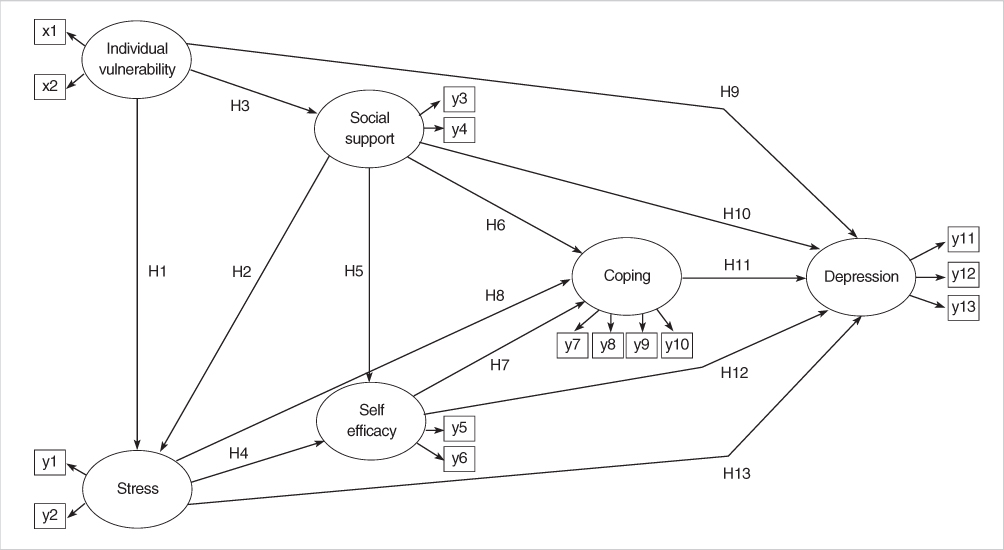

Figure 2
Path coefficients for the modified model.
**p≤.01.
x1=vulnerability of personality; x2=family history of mood disorder; y1=facing-task stress; y2=interpersonal stress; y3=social support from parents; y4=social support from friends; y5=general self-efficacy; y6=problem solving self-efficacy; y7=problem focused coping; y8=seeking support coping; y9=emotional coping; y10=wishful thought coping; y11=cognitive depression; y12=emotional depression; y13=physiological depression.


Figure & Data
REFERENCES
Citations
Citations to this article as recorded by 

- Low Self-Rated Health as A Risk Factor for Depression in South Korea: A Survey of Young Males and Females
Yunyoung Kim, Eunsu Jang
Healthcare.2021; 9(4): 452. CrossRef - Effects of Oral Probiotics on Subjective Halitosis, Oral Health, and Psychosocial Health of College Students: A Randomized, Double-Blind, Placebo-Controlled Study
Dong-Suk Lee, Myoungsuk Kim, Seoul-Hee Nam, Mi-Sun Kang, Seung-Ah Lee
International Journal of Environmental Research and Public Health.2021; 18(3): 1143. CrossRef - Undergraduate Students' Parental Attachment and Attitude toward Seeking Professional Help for Mental Health Problems: Mediating Effects of Depressive Vulnerability
Chung Hee Woo, Nam Yi Kim
Journal of Korean Academy of psychiatric and Mental Health Nursing.2021; 30(1): 67. CrossRef - Terapia cognitiva con entrega virtual en trastorno depresivo persistente: estudio de caso
Nathaly Berrío García
Clínica Contemporánea.2019;[Epub] CrossRef - The Effects of Self-Compassion Program on Internalized Shame and Subjective Well-Being in Female University Students with Depressive Mood
Min Jeong Kang, Jung-Ho Kim, Mirihae Kim
STRESS.2019; 27(4): 464. CrossRef - Exercise Addiction and Psychophysiological Health in Korean Collegiate Students
Yong-Seok Jee, Denny Eun
International Journal of Mental Health and Addiction.2018; 16(2): 451. CrossRef - Effect of Type D Personality on Life Stress in University Students
Mi-Kyeong Jeon, Yu Jeong Kim
Korean Journal of Stress Research.2017; 25(3): 188. CrossRef - The Convergent Effect of Stress, Social support, and Self-esteem on Depression in Female Students
Sun-young Lee, Jeong-sook Lee
Journal of Digital Convergence.2016; 14(12): 335. CrossRef - A Study on the Mediation Effects of Depression and Self-efficacy on College Students' Stress and Subjective Happiness
Seong-Ah Ahn, Mi-Young Sim
Journal of the Korea Academia-Industrial cooperation Society.2015; 16(10): 7021. CrossRef - Factors Influencing Depression among Nursing Students
Su Jeong Yu, Mi Ryeong Song, Eun Man Kim
The Journal of Korean Academic Society of Nursing Education.2014; 20(1): 71. CrossRef - Depressive symptoms in medical students: prevalence and related factors
Bomi Kim, Hyerin Roh
Korean Journal of Medical Education.2014; 26(1): 53. CrossRef - Factors Affecting Depression of Korean Female University Students
Kyung-Sook Lee, Chin-Kang Koh, Joo Hyun Kim, Haeng-Mi Son, Mi Ryeong Song, Su Jeong Yu, Kyung Sook Cho
Journal of muscle and joint health.2013; 20(2): 112. CrossRef - Impact of Stress on Depression among University Students: Testing for Moderating Effect of Social Support
Young Rye Park, Eun Hee Jang
Korean Journal of Adult Nursing.2013; 25(5): 549. CrossRef - Comparison of Depression and Life-stress by Values in University Students
Hae-Ok Jeon
Journal of the Korea Academia-Industrial cooperation Society.2012; 13(5): 2148. CrossRef
Development of a Structural Equation Model to estimate University Students' Depression

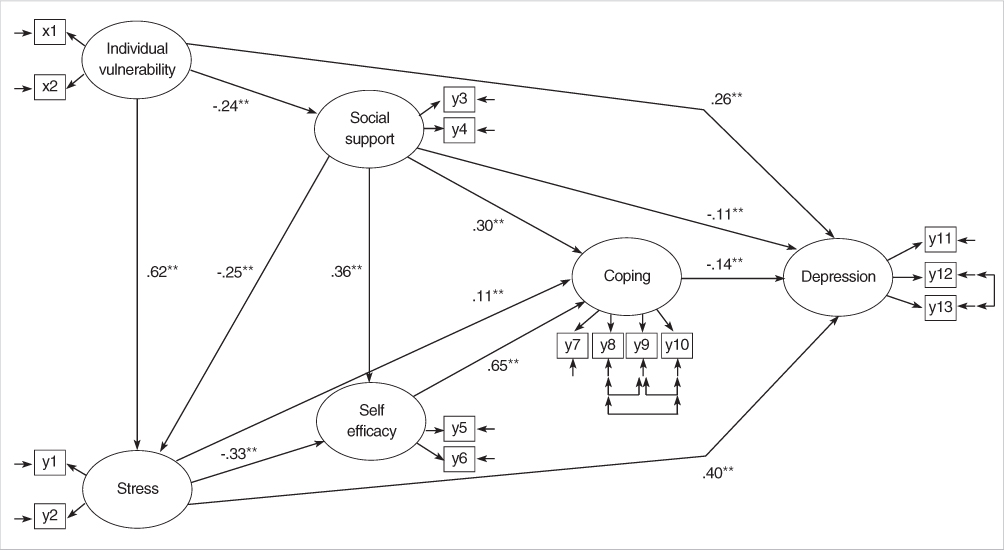
Figure 1
Hypothetical model.
x1=vulnerability of personality; x2=family history of mood disorder; y1=facing-task stress; y2=interpersonal stress; y3=social support from parents; y4=social support from friends; y5=general self-efficacy; y6=problem solving self-efficacy; y7=problem focused coping; y8=seeking support coping; y9=emotional coping; y10=wishful thought coping; y11=cognitive depression; y12=emotional depression; y13=physiological depression.
Figure 2
Path coefficients for the modified model.
**p≤.01.
x1=vulnerability of personality; x2=family history of mood disorder; y1=facing-task stress; y2=interpersonal stress; y3=social support from parents; y4=social support from friends; y5=general self-efficacy; y6=problem solving self-efficacy; y7=problem focused coping; y8=seeking support coping; y9=emotional coping; y10=wishful thought coping; y11=cognitive depression; y12=emotional depression; y13=physiological depression.
Figure 1
Figure 2
Development of a Structural Equation Model to estimate University Students' Depression
Descriptive Statistics for Observed Variables (N=1,640)
***p<.001; †Kolmogorov-Smirnov, test of normality.
Pearson Coefficient Correlations for Measured Variables (N=1,640)
*p≤.05; **p≤.01.
Parameter Estimates for Modified Structural Model and Standardized Direct, Indirect, and Total Effects in Modified Model (N=1,640)
**p≤.01; ***p≤.001.
†standardized parameter; ‡critical ratio; §squared multiple correlation.
Table 1
Descriptive Statistics for Observed Variables (N=1,640)
***p<.001; †Kolmogorov-Smirnov, test of normality.
Table 2
Pearson Coefficient Correlations for Measured Variables (N=1,640)
*p≤.05; **p≤.01.
Table 3
Parameter Estimates for Modified Structural Model and Standardized Direct, Indirect, and Total Effects in Modified Model (N=1,640)
**p≤.01; ***p≤.001. †standardized parameter; ‡critical ratio; §squared multiple correlation.
 KSNS
KSNS
 E-SUBMISSION
E-SUBMISSION
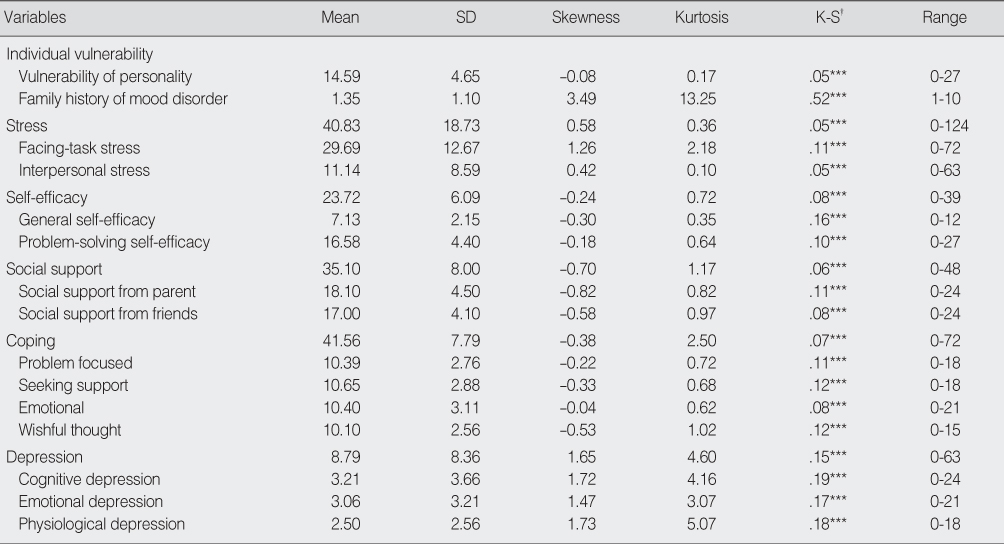
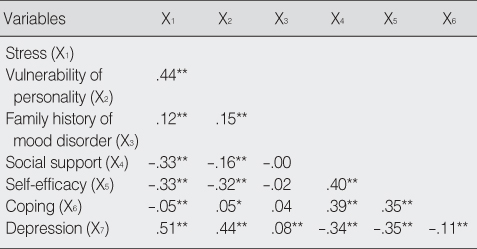
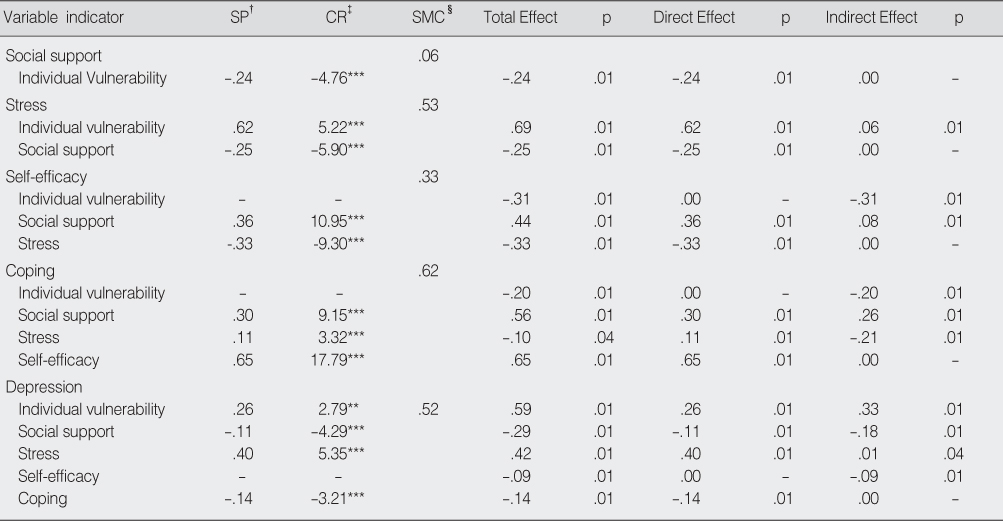
 Cite
Cite

